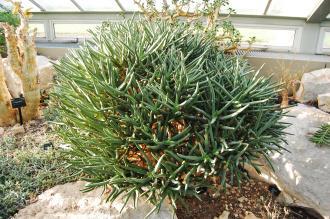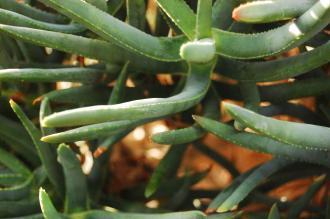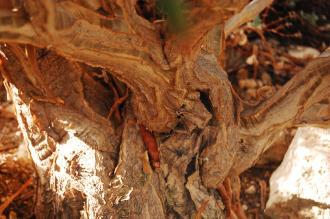
Aloe ramosissima (16/01/2016, Kew Gardens, London)
Position: Full sun
Flowering period: Winter
Soil: Moist, very well drained
Eventual Height: 2m
Eventual Spread: 2m
Hardiness: 10a, 10b, 11
Family: Xanthorrhoeaceae
Sub Family: Asphodeloideae
Aloe ramosissima is a slow growing evergreen perennial shrub with a branched, bushy habit. Its grey/ green fleshy leaves are oblong with serrated margins, up to 20cm long and 2cm across. Its yellow flowers appear on a robust branched flower spike which are up to 20cm long.

Aloe ramosissima Leaf (16/01/2016, Kew Gardens, London)
Aloe ramosissima, commonly known as Maiden’s Quiver Tree, is native to north west South Africa. In its native habitat it grows in arid rocky hills and mountains. Aloe ramosissima is considered to be Vulnerable by The IUCN Red List of Threatened Species.
The etymological root of the binomial name Aloe is derived from the Semetic alloeh a name for this genus. Ramosissima is derived from the Latin ramosus meaning ‘having may branches’.
The landscape architect may find Aloe ramosissima useful as a specimen plant in a rock or desert garden setting. It is also suitable a container grown houseplant in a bright location. Once established this plant is drought tollerant.

Aloe ramosissima Bark (16/01/2016, Kew Gardens, London)
Ecologically, Aloe ramosissima flowers are attractive to some pollinating insects, including bees.
Aloe ramosissima prefers moist, very well-drained soils. It tolerates most pH of soil. It will not tolerate wet soils.
When maintaining Aloe ramosissima as a houseplant its soil should be watered sparingly. Watering should be reduced during the winter months. Its preferred active growing temperature rages from between 18ºc to 24ºc. Feeding with weak fertiliser solution should be carried out once a month during the growing season.

Landscape Architecture

